Previous Designs for the American Flag
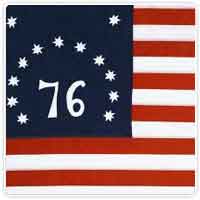
Previous Designs for the American Flag
The United States of America was formed through great trials, bravery, and well-earned triumphs. The white stars and red and white stripes of the American flag serve to symbolize and canonize that effort; however, the American flag has not always appeared as it is known today. Early American flag designs featured different numbers of stars, unique American flag layouts, and obscure symbols that represented the country’s transformation into the current-day United States American Flag.
The Evolution of Old Glory
The red represents hardiness and valor; white symbolizes purity and innocence, and blue stands for vigilance, perseverance, and justice on today’s American flag of 13 red and white alternating stripes and 50 white stars on a sea of blue.
Flags to Represent a Growing Nation
As we all know, the United States of America was formed through a great deal of adversity. As America was forged, American flag designs gradually evolved to become the banner of glory U.S. citizens know and salute today.
The Grand Union Flag is noted for being the first national banner. The Grand Union Flag dons 13 alternate red and white stripes and the British Union Jack (also known as the red cross of St. George of England) in the upper left-hand corner.
- This was the flag of the Revolution and was famously hoisted at George Washington’s base at Prospect Hill when the Continental Army was taken over by the British Army in 1776.
- Because it was flown in Cambridge, Massachusetts, it is also referred to as the Cambridge Flag. It has also been referred to as the First Navy Ensign and the Congress Colors.
- It was also flown on the masts of Washington’s boats as he crossed the Delaware in 1775, a scene famously painted by American artist Emanuel Leutze in 1851.
Interestingly, Leutze’s Washington Crossing the Delaware appears to wave the Betsy Ross flag, not the Grand Union.
Many attribute Betsy Ross for making the first American flag, though there is no proof to support this. Regardless, Ross is one of the most famous Old Glory makers for the infant United States. In 1870, a relation of Ross’ reported that the flag-maker was commissioned by General Washington and a Congressional committee to make a flag from a drawing. Betsy Ross’ flag has the white stars arranged in a circle in the top left corner of the flag atop a canvas of blue. Similar to today’s version, the Betsy Ross flag of 1776 also features 13 alternating red and white stripes to represent the original 13 American colonies. Despite the debatable nature of the validity to the Betsy Ross legend, the Betsy Ross flag as we know it today was known to have been in use by 1777.
In 1777, the Continental Congress passed the first Flag Act as a means to establish an official American flag design for the newly formed United States. The Act established that the U.S. flag would be comprised of thirteen stripes, alternating red and white, and the union would be thirteen white stars on a field of blue symbolizing a new constellation.
This was probably a good idea as raising the Grand Union standard bore image of the then-enemy’s symbol. Thus, the American flag design we know as the Stars & Stripes came to be. In 1794, two more stars were added to the flag’s original 13 to accommodate the addition of Vermont and Kentucky to the Union. This would not change until the Flag Act of 1818 was enacted, whereby the number of stripes was to remain at 13 to represent the original colonies, while the number of stars was to match the number of states currently in the Union.
Prior to the declaration that would add more stars to the flag, the Star-Spangled Banner flag was created. This 30 x 42 foot garrison flag made by Mary Pickersgill and three others featured the trademark red and white stripes and fifteen staggered stars atop the blue canvas on the top corner of the flag.
- The giant flag was raised September 14, 1814 at Fort McHenry in Baltimore as a means to celebrate a critical victory over the British during the war of 1812.
- Reportedly, it was the sight of the massive flag’s stars and stripes that inspired Francis Scott Key to write the song we know today as the national anthem, the “Star-Spangled Banner.”
Lesser Known Banners of Patriotism
Not all American flags resemble the Old Glory as we know it today, as colonies, states, citizens, and organizations were once able to create their own American flag. As a result there are several different American flag designs that still represent our nation’s founding principles, regardless of their unofficial status.
A great example is the Bennington Flag (early 1800s). Easily identified by the large 76 in the canton, this flag features 11 stars in an arc over the numerals 76 with two stars in the upper right and left-hand corners of the Stars & Stripes flag. Similar to Stars & Stripes, the Bennington Flag has 13 alternating red and white stripes, however, the Bennington is unique in that the outermost stripes are white rather than red.
- This flag may have been created during the War of 1812 and was said to have been flown over General John Starks’ encampment during the Battle of Bennington, , which is where the flag derives its name.
- The Bennington Flag’s “76” is present to commemorate America’s victory during the Revolution as a means of inspiration during the more trying times of the War of 1812.
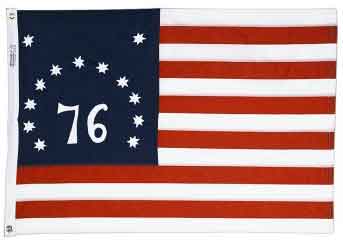
Even more obscure than the Bennington Flag is the Taunton Flag. This flag flew just before the outbreak of the American Revolution.
- The Taunton Flag features a red canvas with the Union Jack in the top left corner (somewhat similar to the Grand Union flag) with the text “Liberty and Union” written across it.
- The Taunton Flag is characteristic of early American flags. Many of these colonial flags derived their design from the British Red Ensign and the flag of Great Britain.
- This flag was flown by the citizens of Taunton, Massachusetts in 1774 as a pre-Revolutionary symbol of loyalty to the colonies.
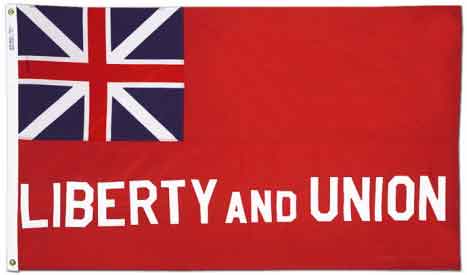
The First Navy Jack Flag depicts the red and white stripes across the flag with a yellow and red snake lying across it on a diagonal with the “Don’t tread on me” text printed beneath it. Although there is widespread belief that the Continental Navy flew this flag, there is no substantial evidence to confirm it. The rattlesnake first appeared as a symbol of the 13 original colonies around the time of the Seven Years War (1756-1763) usually appearing with “Don’t Tread on Me,” and by the time of the Revolutionary War was a common symbol for the United States, representing its independent spirit and resistance to tyranny.
Derived from the First Navy Jack, another American flag that also features a rattlesnake and that has seen a resurgence in popularity in recent years is the Gadsden Flag. This American flag design depicts a coiled American timber rattlesnake poised atop a yellow canvas with the text “Don’t tread on me,” printed beneath it.
- This image was all over the 1775 colonies; it was on flags and banners as well as paper money and on uniform buttons.
- It made its appearance via U.S. Marine Corps who were enlisted on a mission to commandeer firearms from an incoming British ship during the time of the Battle of Bunker Hill.
- An anonymous “American Guesser,” that many speculate to be Benjamin Franklin, observed that the rattlesnake was a prime American representation as (1) the rattlesnake is only found in America, and (2) the rattlesnake never initiates an attack nor does she surrender once engaged in attack making her a symbol of courage.
- The Guesser also observed that the rattlesnake had 13 rattles, exactly the same as the number of American colonies, which though independent of one another were also firmly united together and were capable of producing a truly fearsome sound.
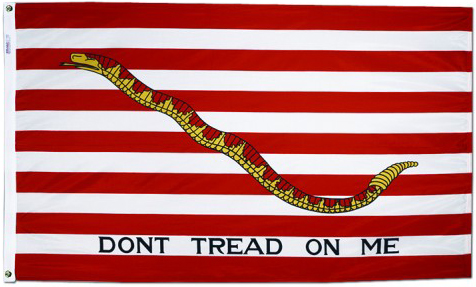
Though the Gadsden Flag bears no resemblance to any of the official American flags throughout history, it does symbolize what America stands for. Patterns and designs change over time. However, the spirit and intent for which they have been sewn remains consistent. Since its inception, the American flag has been a symbol of freedom and bravery and it will continue to represent those virtues.
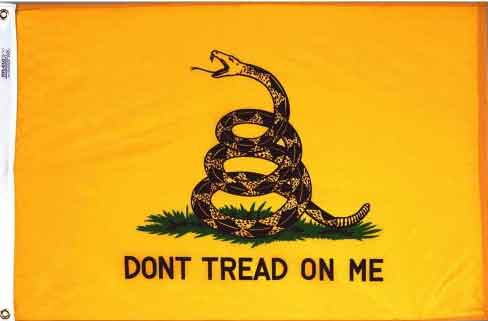
All Star Flags specializes in the high quality distribution and production of all types of flags: United States, individual state, military, international, and custom designs. All Star Flags also handles in the sale of banners, pennants, banners and signs, and flag accessories. Their inventory includes a unique selection of previous versions of the American flag. All Star Flags sells only made in USA flag products and distributes nation-wide making it the go-to distributor for anyone looking to have a piece of history.
By Chad Creech, All Star Flags
